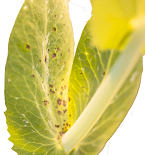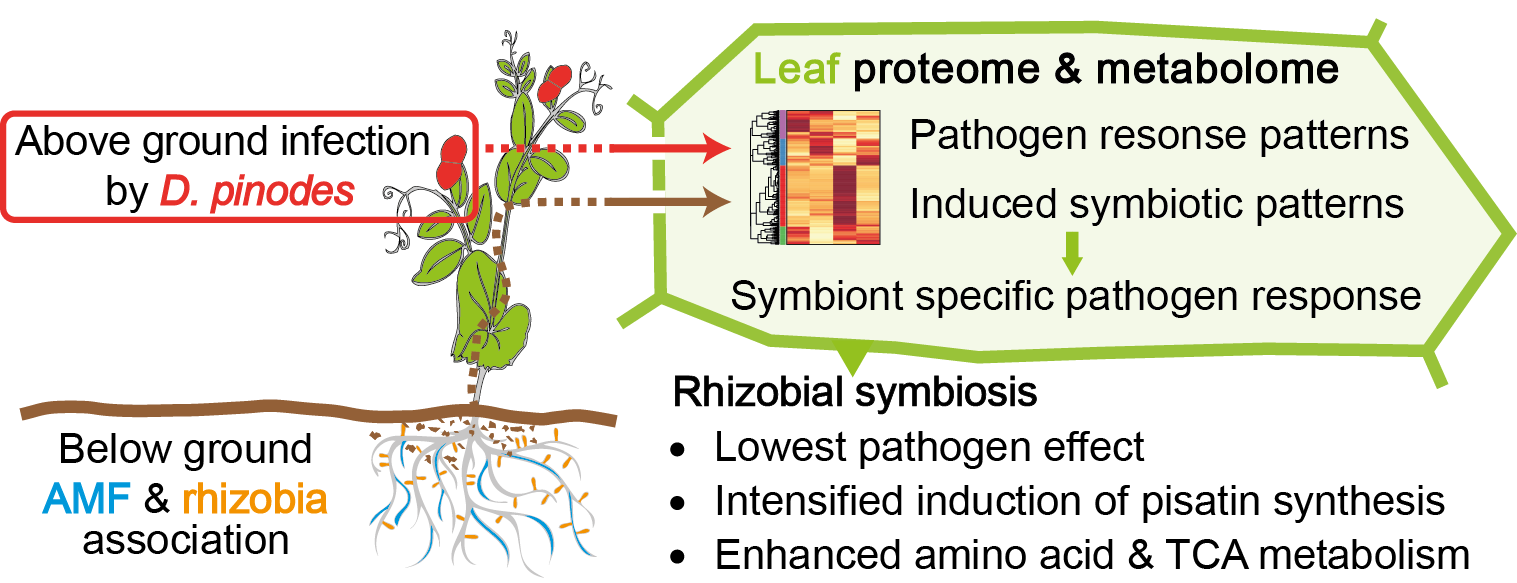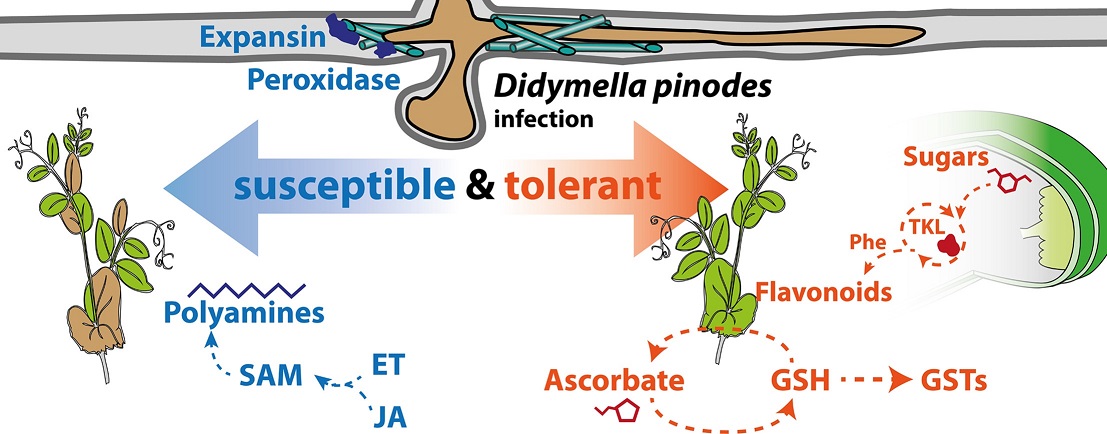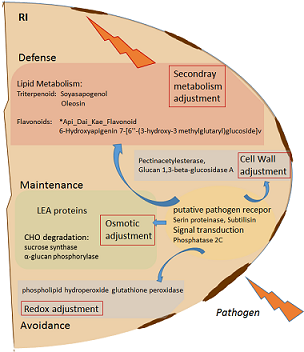|
Final Report
Biotic stress caused by microorganisms is omnipresent, however just a few pathogens possess the biochemical arsenal to invade a host. Ascochyta blight was long time thought to be a host specific disease of
Pisum sativum, but is now known to infect many alternative legume hosts. Still, pea is the main host and significant yield losses are recorded globally every year. The causing agent in this fungi complex is known to be
Didymella pinodes. The current knowledge about the biochemical stress response of the plant is still limited. Like the multitude of effects a pathogen has on its host, are the great influences of beneficial microbes on the plant metabolism. In case of legumes it is the essential relation with rhizobia, but also mycorrhiza. This relation is much specialized as rhizobia alter the plants immune system to influence a defense response.
This comprehensive study focused on components of the host plant, interacting with pathogens and beneficial microbes. By applying high-throughput methods, systems biology provides an overall picture of the metabolic impact of the symbionts on the host, as well as of the stress response against D. pinodes. The susceptible pea cultivar Messire was compared with a more tolerant cultivar Protecta. The whole plant was phenotypically analyzed in relation to the different treatments (e.g. fresh and dry weight, seed yield, nodule and mycrosymbiont abundance, degree of pathogen disease and more). Leaves and seeds were in depth analyzed, applying metabolomics and proteomics, resulting in several publications.
Major findings:
1. Belowground symbiontic effects on aboveground morphology and metabolic dynamics of the host plant (leaves and seeds)
We found that both microsymbions induced changes in RNA metabolism and protein biosynthesis. Mycorrhiza alone influenced metabolic processes involved in metal handling and ROS-scavenging. Co-inoculation with Rhizobium and mycorrhiza was leading to an antagonistic effect of the symbionts. It caused reduction of colonization for both symbionts and inhibition of plant growth.
Altogether, the metabolic influences of the microsymbionts were stronger in the susceptible pea cultivar Messire, however, not more efficient concerning pathogen resistance than in cultivar Protecta.
2. Pathogen attack has a negative impact on the belowground microsymbionts (Rhizobium and/or
mycorrhiza) efficiency
D. pinodes infestation had a reduced effect on of mycorrhiza root colonization and
Rhizobium root nodule density. In addition, nodule dry weight and number were decreased as well as nodule specific metabolism reduced. This effect was strongest in cultivar Messire.
3. Host-mediated effects of belowground symbionts on above ground
D. pinodes severity to P. sativum:
Rhizobium symbiosis increases protection of the plants growth and seed yield by reducing pathogen disease severity
The general defense response against D. pinodes was characterized by accumulation of proteins involved in ROS disposal and activation of secondary metabolism including proteins of the
P. sativum typical pisatin pathway (i.g. 6a-hydroxymaackiain 3-O-methyltrans-ferase). The legumes inherent interaction with rhizobia lead to enhanced activation of the citric acid cycle, amino acid metabolism and secondary metabolism including proteins involved in the synthesis of leaf pisatin. In seeds, an accumulation of „Late embryogenesis Abundant“ (LEA) proteins was found, which thus far is only known as a protective mechanism against abiotic stress, mainly drought. Additionally the seed triterpenoid Soyasapogenol was highly induced upon pathogen attack, especially in the tolerant pea cultivar.
The data indicate that leaf and seed defense is mediated by the phenomena of induced systemic resistance. This is leading to an accelerated synthesis of defense compounds. In any case,
Rhizobium inoculated pea plants showed the smallest pathogen disease severity in leaves and seeds for both cultivars.
The more effective defense response of the tolerant cultivar distinguished from the susceptible cultivar through sustainment of photosynthesis, provision of sugars and carbon skeletons supplying secondary metabolism. In addition, sulphur metabolism, functioning of the glutathione-ascorbate hub and hormonal adjustment to avoid induced cell death seem to promote tolerance.
We can conclude that the strategy of maintenance of the more resistant cultivar has a higher success than avoidance of the susceptible cultivar.
Summary & Highlights:
• Microsymbionts have a strong influence on the metabolism and hence the phenotype of the host plant. However, mode of action and effectiveness depend on symbiont (rhizobia or mycorrhiza) as well as pea cultivar.
• The pathogen represses/reduces formation of symbioses and thus symbiotic efficiency.
• Rhizobium-Symbiosis inhibits infestation and impact of the pathogen on the plant through a so called Induced Systemic Resistance (ISR). Through this, specific defense mechanisms of the plant are accelerated and/or enhanced respectively. In order to understand the temporal factor of acceleration, further studies are needed.
• The co-symbiosis of rhizobia and mycorrhiza had an unfavorable influence on the plants growth. In addition, microsymbionts showed an antagonistic effect against each other. Possibly, a combination of other plant-microbe (cultivar-strains) symbioses or a difference in the sequence of microbe-inoculation may lead to better results. Further investigations will be necessary.
• All proteomics analyses publishe thus far are also deposited and public available in the database PRIDE. This includes a proteome database (fasta formate) we complemented with de novo sequence information of the two cultivars.
This project has substantially contributed to a comprehensive insight into the different pathogen defense strategies of pea plants and the important role of microsymbionts for improved agricultural bio-control. Hence, future beeding strategies in legumes should focus more on
Rhizobium inoculation rather than N-fertilization.
|






